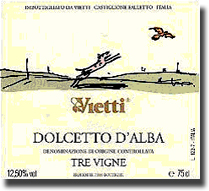|
||||
|
|
||||
|
|
||||
|
not an ingredient.” – Luca Carrado 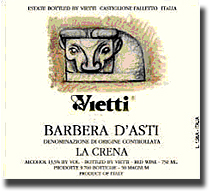 2003 Vietti Barbera d’Asti La Crena, 14.5% alc., $45.99: Deep, dark color; on
the nose, notes of sea air, licorice and “sticksy” underbrush accent the black
currant and blackberry aromas. The like flavors are rich, ripe, dense and
impressive, once again showing just a kiss of oak. Full bodied, with excellent
structure and length; quite lovely. Sourced from the single vineyard La Crena in
Agliano d’Asti with 3,800 plants by hectare, which are over 65 years old. Spends
8 days in stainless steel tanks; after malolactic fermentation, moved into
French oak barrels for 16 months, then assembled in steel tank until bottling
(unfiltered). Find this wine 2003 Vietti Barbera d’Asti La Crena, 14.5% alc., $45.99: Deep, dark color; on
the nose, notes of sea air, licorice and “sticksy” underbrush accent the black
currant and blackberry aromas. The like flavors are rich, ripe, dense and
impressive, once again showing just a kiss of oak. Full bodied, with excellent
structure and length; quite lovely. Sourced from the single vineyard La Crena in
Agliano d’Asti with 3,800 plants by hectare, which are over 65 years old. Spends
8 days in stainless steel tanks; after malolactic fermentation, moved into
French oak barrels for 16 months, then assembled in steel tank until bottling
(unfiltered). Find this wine 2005 Vietti Barbera d'Alba Tre Vigne, 14% alc., $28.99: Good dark color, with earth, sticks, black currant and blackberry on the nose; a little less ripe in the mouth than the ’05 Barbera d’Asti Tre Vigne, with a little more earth, mineral and underbrush. Sleek, yet full bodied, well structured, long on the finish, and while not “rustic,” perhaps a little less “modern” than the Vietti Barbera d’Astis. Sourced from three 30/35 year old vineyard sites located in Monforte, Barolo and Castiglione Falletto with 4,300 vines by hectare. Kept in stainless steel tanks for 7 days at 26°C for alcoholic fermentation, then moved into 33 hl casks at the beginning of malolactic fermentation for 8 months. The wine is then transferred into large stainless steel tanks for blending, followed by two transfers into stainless steel tanks before bottling (unfiltered). Find this wine 2005 Vietti Barbera d'Alba Scarrone, 14% alc., $46.99: Almost opaque in color, with a mélange of expressive floral, earth, underbrush, licorice and black fruit flavors and aromas, showing serious concentration and intensity. Dense and well structured, this can be enjoyed now with some air, or you can put it down for five or ten years. Sourced from the 60-year-old Scarrone single vineyard situated close to the winery in Castiglione, planted with 4,600 plants per hectare. Spends 8 days in stainless steel tanks for the alcoholic fermentation at 26/28° C. At the beginning of malolactic fermentation, the wine is moved into French oak barrels for 16 months, then held in stainless steel tanks for 2 months before bottling (unfiltered). Find this wine 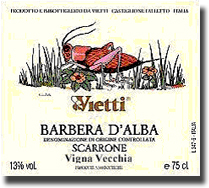 2005
Vietti Barbera d'Alba Scarrone Vigna Vecchia, 14% alc., $81.99: Sourced from
vines of more than 85 years of age, this deeply colored Barbera exudes leather,
licorice, earth, black plum and berry on the nose, all graced with subtle floral
hints; the rich, ripe and concentrated flavors echo and expand dramatically with
a pretty kiss of oak and great depth of fruit. So nice already that it’s hard to
keep hands off now, but it shows great potential for aging.
The grapes are
severely selected from this vineyard, cultivated with 4,300 plants by ha. Vinification begins in stainless steel tanks for 8 days at 30° C with frequent
pumping over; the wine is then moved into French oak barrels at the beginning of
malolactic fermentation, where it remains for 18 months. The wine is assembled
in stainless steel tank before bottling. Find this wine 2005
Vietti Barbera d'Alba Scarrone Vigna Vecchia, 14% alc., $81.99: Sourced from
vines of more than 85 years of age, this deeply colored Barbera exudes leather,
licorice, earth, black plum and berry on the nose, all graced with subtle floral
hints; the rich, ripe and concentrated flavors echo and expand dramatically with
a pretty kiss of oak and great depth of fruit. So nice already that it’s hard to
keep hands off now, but it shows great potential for aging.
The grapes are
severely selected from this vineyard, cultivated with 4,300 plants by ha. Vinification begins in stainless steel tanks for 8 days at 30° C with frequent
pumping over; the wine is then moved into French oak barrels at the beginning of
malolactic fermentation, where it remains for 18 months. The wine is assembled
in stainless steel tank before bottling. Find this wine2005 Vietti Perbacco Nebbiolo, 13.5% alc., $29.99: This is not simple Nebbiolo, but 100% legal Barolo; winemaker Luca Carrado calls this their “baby Barolo.” Showing a slightly smoky tinge to its dark color, with restrained earthy black fruit and underbrush that echoes and expands considerably on the palate. An earthy, full-bodied wine, sleek yet well structured, for drinking now and over the next three to five years. No frills or pretensions, just solid, straightforward Nebbiolo. The grapes are selected from young vineyards in Castiglione, La Morra and Novello that are planted 4,500-5,000 plants by hectare. Alcoholic and malolactic fermentation occur in stainless steel tanks at 26-28° C. The wine is moved into casks for 8 months, and then transferred to stainless steel tanks until bottling. Find this wine 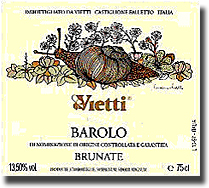 2003
Vietti Barolo Brunate, 14.5% alc., $108.99: Smoke tinged garnet color, with
“sticksy” aromatics of black fruit and tobacco, kissed with a note of oak and
floral hints; lots more of the same on the palate, being even more floral with
an added note of blueberry. Silky, refined and deceptively well-structured; so
fine now and yet full of promise for further development.
Sourced from the historical cru Brunate, located in La Morra, planted 4,500
plants per hectare. The vines are 40 years old and grown using the Guyot system.
Alcoholic fermentation occurs for 12 days at 30/32° C in stainless steel tanks
with automatic and manual pumping up, followed by malolactic fermentation. The
wine is aged for 12 months in used French barrels, followed by an additional 24
months in cask, then assembled in stainless steel tanks and kept there until the
bottling (unfiltered). Find this wine 2003
Vietti Barolo Brunate, 14.5% alc., $108.99: Smoke tinged garnet color, with
“sticksy” aromatics of black fruit and tobacco, kissed with a note of oak and
floral hints; lots more of the same on the palate, being even more floral with
an added note of blueberry. Silky, refined and deceptively well-structured; so
fine now and yet full of promise for further development.
Sourced from the historical cru Brunate, located in La Morra, planted 4,500
plants per hectare. The vines are 40 years old and grown using the Guyot system.
Alcoholic fermentation occurs for 12 days at 30/32° C in stainless steel tanks
with automatic and manual pumping up, followed by malolactic fermentation. The
wine is aged for 12 months in used French barrels, followed by an additional 24
months in cask, then assembled in stainless steel tanks and kept there until the
bottling (unfiltered). Find this wine2003 Vietti Barolo Lazzarito, 14.5% alc., $108.99: Smoke tinged garnet color, with a “sticksy” licorice and black fruit nose, graced with a pretty floral note, all following through on the palate very nicely. Perhaps less immediately ravishing and a bit more earthy that the Brunate after just having tasted that one, but very nice in its own regard, being silky and well structured for several years of future development. Sourced from the single vineyard Lazzarito in Serralunga, which has 4,300 plants by hectare that are 35 years old. Spends 11 days in stainless steel tanks for alcoholic fermentation at 30° C., then aged for 14 months in French oak barrels and another 14 months in Slovenian oak casks. It is then moved into stainless steel tanks until the bottling (unfiltered). Find this wine 2003 Vietti Barolo Rocche, 14.5% alc., $108.99: Good dark color with a slight tinge of smoke and a lovely, floral perfume of black fruit, blueberry, earth, underbrush and leather that follow through beautifully on the palate. Silky, yet well structured, so you can drink it now or drink it in 10 years. Sourced from the 45 year old vineyards in Roche of Castiglione, cultivated with 4,600 plants per hectare. Spends 13 days in stainless steel tanks at 30-32°C with frequent pumping over during the alcoholic fermentation, followed by malolactic fermentation. The wine is then aged in Slovenian oak cask for 26 months and transferred into stainless steel tanks for 6 months rest, before bottling. Find this wine 2001 Vietti Barolo Rocche, 14% alc.: This was poured to add another perspective on the Vietti Barolo Rocche experience. Smoke tinged garnet in color, with smoke, sticks and licorice on the nose, all of which takes a supporting role in the flavors to accent the rich, leathery black fruit. Rich, silky and deceptively structured; great now with food, and even better down the road. Find this wine 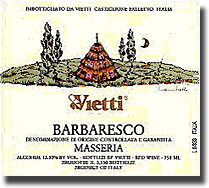 2003
Vietti Barbaresco Masseria, 14% alc., $108.99: Dark garnet color with a
slightly smoky tinge to it; floral hints grace subtle earth, underbrush and
black and blue fruits on the nose, echoing and expanding in the rich, luscious
flavors. Sleek, silky, deceptively well structured and long on the finish. I
could drink this on a regular basis already, but it has a very nice future ahead
of it. The grapes are harvested from the cru Masseria, located in Neive, where
the vines are planted with 4,600 plants per hectare; vines are 40 years old and
are grown by the Guyot system. Spends 13 days in open stainless steel tanks at
30 to 32° C for the alcoholic fermentation, which is immediately followed by
malolactic fermentation with frequent pumping over. Aged in casks for 24 months
then blended in stainless steel tanks one month before bottling (unfiltered). Find this wine 2003
Vietti Barbaresco Masseria, 14% alc., $108.99: Dark garnet color with a
slightly smoky tinge to it; floral hints grace subtle earth, underbrush and
black and blue fruits on the nose, echoing and expanding in the rich, luscious
flavors. Sleek, silky, deceptively well structured and long on the finish. I
could drink this on a regular basis already, but it has a very nice future ahead
of it. The grapes are harvested from the cru Masseria, located in Neive, where
the vines are planted with 4,600 plants per hectare; vines are 40 years old and
are grown by the Guyot system. Spends 13 days in open stainless steel tanks at
30 to 32° C for the alcoholic fermentation, which is immediately followed by
malolactic fermentation with frequent pumping over. Aged in casks for 24 months
then blended in stainless steel tanks one month before bottling (unfiltered). Find this wine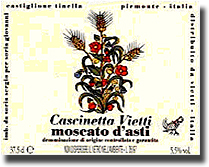 2007
Vietti Moscato d'Asti Cascinetta, 5.5% alc., $16.99: Moscato grapes, whether vinified
or au natural, are so distinctive in flavor, and this medium straw colored
spritzy little delight is quintessential Moscato, somewhat effervescent and
sweet without being at all cloying. Medium bodied, rich, zesty and eminently
drinkable, it serves equally well as an aperitif or an after dinner drink.
Selected from different vineyards located in Castiglione Tinella, with only the
best grapes used. The vineyards are planted with 4,500 plants per hectare, with
a medium age of 34 years. Grapes are crushed, pressed and clarified. Before the
bottling yeast is added and the temperature is raised to 12°-14° C. Alcoholic
fermentation occurs in stainless steel autoclave, to preserve some natural CO2.
There is no malolactic fermentation. At 5.5% alcohol, fermentation is stopped,
and the wine is filtered and bottled. Find this wine 2007
Vietti Moscato d'Asti Cascinetta, 5.5% alc., $16.99: Moscato grapes, whether vinified
or au natural, are so distinctive in flavor, and this medium straw colored
spritzy little delight is quintessential Moscato, somewhat effervescent and
sweet without being at all cloying. Medium bodied, rich, zesty and eminently
drinkable, it serves equally well as an aperitif or an after dinner drink.
Selected from different vineyards located in Castiglione Tinella, with only the
best grapes used. The vineyards are planted with 4,500 plants per hectare, with
a medium age of 34 years. Grapes are crushed, pressed and clarified. Before the
bottling yeast is added and the temperature is raised to 12°-14° C. Alcoholic
fermentation occurs in stainless steel autoclave, to preserve some natural CO2.
There is no malolactic fermentation. At 5.5% alcohol, fermentation is stopped,
and the wine is filtered and bottled. Find this wine Reporting from Day-twah,
Bastardo
Other Recent Wine Explorations
More Red Wings & Red Rhônes 2007: Champagne Tablas Swan Zin (a real mixed bag of goodies)
Old
Friends & New Faces
Back to the Underground Index
|
||||

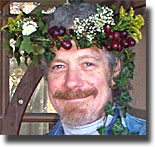
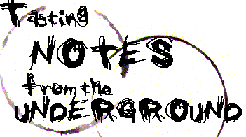

 Luca
Carrado returned to the Detroit
area recently for a series of tastings and winemaker’s dinners promoting his
family’s fine lineup of
Luca
Carrado returned to the Detroit
area recently for a series of tastings and winemaker’s dinners promoting his
family’s fine lineup of

